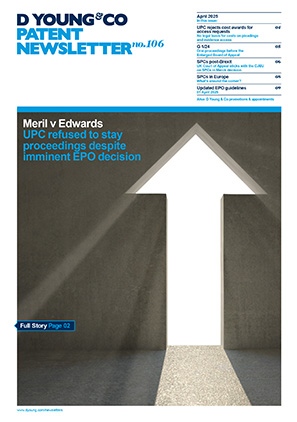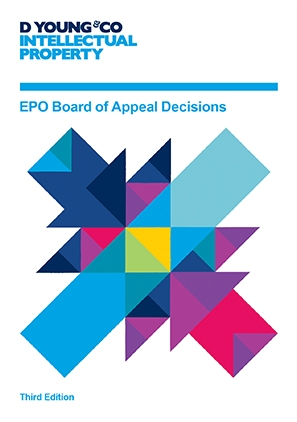G 2/21: questions on the correct plausibility standard referred to the Enlarged Board of Appeal
We recently reported on the provisional referral of three questions to the Enlarged Board of Appeal by the Board of Appeal presiding over case T 116/18, an appeal from the decision of the Opposition Division rejecting Syngenta’s opposition against Sumitomo’s European Patent 2484209. The European Patent Office (EPO) has now officially confirmed that these three questions will be considered by the Enlarged Board of Appeal under case G 2/21 .
Latest update on this subject
G2/21: Enlarged Board of Appeal issues its decision 24 March 2023.
Read moreThe three questions referred to the Enlarged Board of Appeal are:
“1. Should an exception to the principle of free evaluation of evidence (see e.g. G 3/97, Reasons 5, and G 1/12, Reasons 31) be accepted in that post-published evidence must be disregarded on the ground that the proof of the effect rests exclusively on the post-published evidence?
2. If the answer is yes (the post-published evidence must be disregarded if the proof of the effect rests exclusively on this evidence), can the post-published evidence be taken into consideration if, based on the information in the patent application in suit or the common general knowledge, the skilled person at the filing date of the patent application in suit would have considered the effect plausible (ab initio plausibility)?
3. If the answer to the first question is yes (the post-published evidence must be disregarded if the proof of the effect rests exclusively on this evidence), can the post-published evidence be taken into consideration if, based on the information in the patent application in suit or the common general knowledge, the skilled person at the filing date of the patent application in suit would have seen no reason to consider the effect implausible (ab initio implausibility)?”
Assessing plausibility
The three questions referred to the Enlarged Board of Appeal thus concern whether, and under what conditions, experimental data provided by the patentee only after the filing date of the patent (so called “post-published” evidence) may be taken into account for the assessment of sufficiency and inventive step. Established case law of the EPO requires that for such data to be taken into account, it must be “plausible” from the application as filed in combination with common general knowledge that the technical effect allegedly demonstrated by the post-published data was indeed achieved at the filing date of the patent in question. However, as one might expect, the standard applied to establish whether such an effect is indeed “plausible” or not has often proved controversial, especially when the outcome of a particular case hinged on whether post-published evidence was taken into account or not. Following an extensive review of the existing case law, the Board of Appeal in T 116/18 decided that a referral to the Enlarged Board of Appeal for clarification on this matter was necessary.
The grounds for the decision of the Board of Appeal in T 116/18 have now been published, providing greater insight as to why these questions were referred to the Enlarged Board of Appeal. Specifically, in the Board of Appeal’s view there exist three diverging strands of case law as to how plausibility should be assessed.
Ab initio plausibility
The first of these strands was termed “ab initio plausibility”. This line of case law held that post-published evidence can only be taken into account if the skilled person would have had reason to assume the alleged technical effect had been achieved at the filing date. In short, the Board of Appeal appeared to consider that when applying this standard, a technical effect is considered implausible by default unless the skilled person would have had reason to consider it plausible based on the patent application as filed or from common knowledge at the filing date of the patent.
Ab initio implausibility
The second strand identified by the Board was termed “ab initio implausibility”. In contrast to the “ab initio plausibility” standard discussed above, the Board of Appeal considered this standard to require that post-published evidence can only be disregarded if the skilled person would have had legitimate reasons to doubt that the alleged technical effect would have been achieved on the filing date of the patent. That is, the Board of Appeal appeared to consider that when applying this standard, a technical effect is considered plausible by default, unless it can be shown the skilled person would have had reasons to think otherwise.
The central practical difference between these two standards thus appears to be the party with which the burden of proof lies. For “ab initio plausibility”, it is the Patentee who must show that a technical effect is indeed plausible, whereas for “ab initio implausibility”, the burden of proof rests on the Opponent to show that a technical effect was not plausible at the filing date of the patent.
The no plausibility standard
The Board of Appeal lastly considered there to be a line of case law that rejected the concept of plausibility altogether, which was termed the “no plausibility” standard. According to the Board of Appeal, the decisions in this line of case law held that the very concept of plausibility is incompatible with the well established problem-solution approach applied by the EPO when assessing inventive step, which allows for reformulation of the technical problem when the patentee is faced with a perhaps previously unknown document as the closest prior art.
After identifying the above allegedly diverging lines of case law, the Board of Appeal provided some discussion that perhaps hinted at which standard it believed to be correct. Specifically, the Board of Appeal considered that the “ab initio plausibility” and the “no plausibility” standards represented “two extremes”, which it appears were both disapproved of.
It was considered that by applying the strict “ab initio plausibility” standard, the patentee is faced with an “insurmountable hurdle” if an opponent invokes a new closest prior art document in opposition proceedings. The Board of Appeal further considered that strict application of this standard would go against longstanding case law that the objective technical problem can be reformulated, so long as the “spirit” of the original invention is preserved. Equally, the Board of Appeal considered that if the “no plausibility” standard were applied, applicants would be able to engage in speculative or “armchair” patenting, by filing patent applications based on pure speculation rather than for a true invention.
The Board of Appeal lastly questioned whether the concept of plausibility was even compatible with the long-standing principle of free evaluation of evidence, by which the EPO departments have the power to decide for themselves how much weight to give to a particular piece of evidence when reaching a decision. It was in particular questioned what legal basis in the EPC could prevent a Board of Appeal from taking into account evidence considered to be convincing.
The Enlarged Board of Appeal will now consider these questions. Its decision could have far reaching implications for users of the EPO patent system. Naturally, any apparent raising of the bar to show plausibility will require applicants to consider more carefully whether the data included in a particular patent application will be sufficient to render plausible any technical effects they may wish to rely on later.
Of course, it is also possible that the Enlarged Board of Appeal will disagree with the referring Board of Appeal that there is any divergence in case law, and decline to set out which of the three standards discussed above is the correct one.
We will keep you updated on the progress of this case and will report on future developments as they arise.
Potential EPO Enlarged Board of Appeal referral: post-published data to support inventive step?
For a summary of the facts of T 116/18, please see our previous article"Potential EPO Enlarged Board of Appeal referral: post-published data to support inventive step?", published 10 August 2021.
Read moreEPO communication regarding G 2/21
View the communication dated 21 October 2021 regarding the referral to the Enlarged Board of Appeal of G 2/21.
Read more

